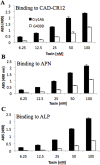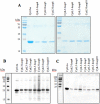Engineering Bacillus thuringiensis Cyt1Aa toxin specificity from dipteran to lepidopteran toxicity
- PMID: 29563565
- PMCID: PMC5862903
- DOI: 10.1038/s41598-018-22740-9
Engineering Bacillus thuringiensis Cyt1Aa toxin specificity from dipteran to lepidopteran toxicity
Abstract
The Cyt and Cry toxins are different pore-forming proteins produced by Bacillus thuringiensis bacteria, and used in insect-pests control. Cry-toxins have a complex mechanism involving interaction with several proteins in the insect gut such as aminopeptidase N (APN), alkaline phosphatase (ALP) and cadherin (CAD). It was shown that the loop regions of domain II of Cry toxins participate in receptor binding. Cyt-toxins are dipteran specific and interact with membrane lipids. We show that Cry1Ab domain II loop3 is involved in binding to APN, ALP and CAD receptors since point mutation Cry1Ab-G439D affected binding to these proteins. We hypothesized that construction of Cyt1A-hybrid proteins providing a binding site that recognizes gut proteins in lepidopteran larvae could result in improved Cyt1Aa toxin toward lepidopteran larvae. We constructed hybrid Cyt1Aa-loop3 proteins with increased binding interaction to Manduca sexta receptors and increased toxicity against two Lepidopteran pests, M. sexta and Plutella xylostella. The hybrid Cyt1Aa-loop3 proteins were severely affected in mosquitocidal activity and showed partial hemolytic activity but retained their capacity to synergize Cry11Aa toxicity against mosquitos. Our data show that insect specificity of Cyt1Aa toxin can be modified by introduction of loop regions from another non-related toxin with different insect specificity.
Conflict of interest statement
The authors declare no competing interests.
Figures







Similar articles
-
Role of alkaline phosphatase from Manduca sexta in the mechanism of action of Bacillus thuringiensis Cry1Ab toxin.J Biol Chem. 2010 Apr 23;285(17):12497-503. doi: 10.1074/jbc.M109.085266. Epub 2010 Feb 22. J Biol Chem. 2010. PMID: 20177063 Free PMC article.
-
Enhancement of Bacillus thuringiensis Cry1Ab and Cry1Fa Toxicity to Spodoptera frugiperda by Domain III Mutations Indicates There Are Two Limiting Steps in Toxicity as Defined by Receptor Binding and Protein Stability.Appl Environ Microbiol. 2018 Oct 1;84(20):e01393-18. doi: 10.1128/AEM.01393-18. Print 2018 Oct 15. Appl Environ Microbiol. 2018. PMID: 30097439 Free PMC article.
-
Bacillus thuringiensis ssp. israelensis Cyt1Aa enhances activity of Cry11Aa toxin by facilitating the formation of a pre-pore oligomeric structure.Cell Microbiol. 2007 Dec;9(12):2931-7. doi: 10.1111/j.1462-5822.2007.01007.x. Epub 2007 Aug 2. Cell Microbiol. 2007. PMID: 17672866 Free PMC article.
-
Pore formation by Cry toxins.Adv Exp Med Biol. 2010;677:127-42. doi: 10.1007/978-1-4419-6327-7_11. Adv Exp Med Biol. 2010. PMID: 20687486 Review.
-
Employing phage display to study the mode of action of Bacillus thuringiensis Cry toxins.Peptides. 2008 Feb;29(2):324-9. doi: 10.1016/j.peptides.2007.07.035. Epub 2007 Dec 14. Peptides. 2008. PMID: 18226423 Free PMC article. Review.
Cited by
-
Identification and recombinant expression of an antimicrobial peptide (cecropin B-like) from soybean pest Anticarsia gemmatalis.J Venom Anim Toxins Incl Trop Dis. 2021 Mar 12;27:e20200127. doi: 10.1590/1678-9199-JVATITD-2020-0127. J Venom Anim Toxins Incl Trop Dis. 2021. PMID: 33796137 Free PMC article.
-
Role of Lectin in the Response of Aedes aegypti Against Bt Toxin.Front Immunol. 2022 May 13;13:898198. doi: 10.3389/fimmu.2022.898198. eCollection 2022. Front Immunol. 2022. PMID: 35634312 Free PMC article. Review.
-
In vivo nanoscale analysis of the dynamic synergistic interaction of Bacillus thuringiensis Cry11Aa and Cyt1Aa toxins in Aedes aegypti.PLoS Pathog. 2021 Jan 19;17(1):e1009199. doi: 10.1371/journal.ppat.1009199. eCollection 2021 Jan. PLoS Pathog. 2021. PMID: 33465145 Free PMC article.
-
Insect chaperones Hsp70 and Hsp90 cooperatively enhance toxicity of Bacillus thuringiensis Cry1A toxins and counteract insect resistance.Front Immunol. 2023 Apr 20;14:1151943. doi: 10.3389/fimmu.2023.1151943. eCollection 2023. Front Immunol. 2023. PMID: 37153577 Free PMC article.
-
Functional Bacillus thuringiensis Cyt1Aa Is Necessary To Synergize Lysinibacillus sphaericus Binary Toxin (Bin) against Bin-Resistant and -Refractory Mosquito Species.Appl Environ Microbiol. 2020 Mar 18;86(7):e02770-19. doi: 10.1128/AEM.02770-19. Print 2020 Mar 18. Appl Environ Microbiol. 2020. PMID: 32005737 Free PMC article.
References
-
- James, C. 20th Anniversary (1996 to 2015) of the Global Commercialization of Biotech Crops and Biotech Crop Highlights in 2015. ISAAA Brief No. 51. ISAAA: Ithaca, NY (2015).
Publication types
MeSH terms
Substances
LinkOut - more resources
Full Text Sources
Other Literature Sources
Miscellaneous

